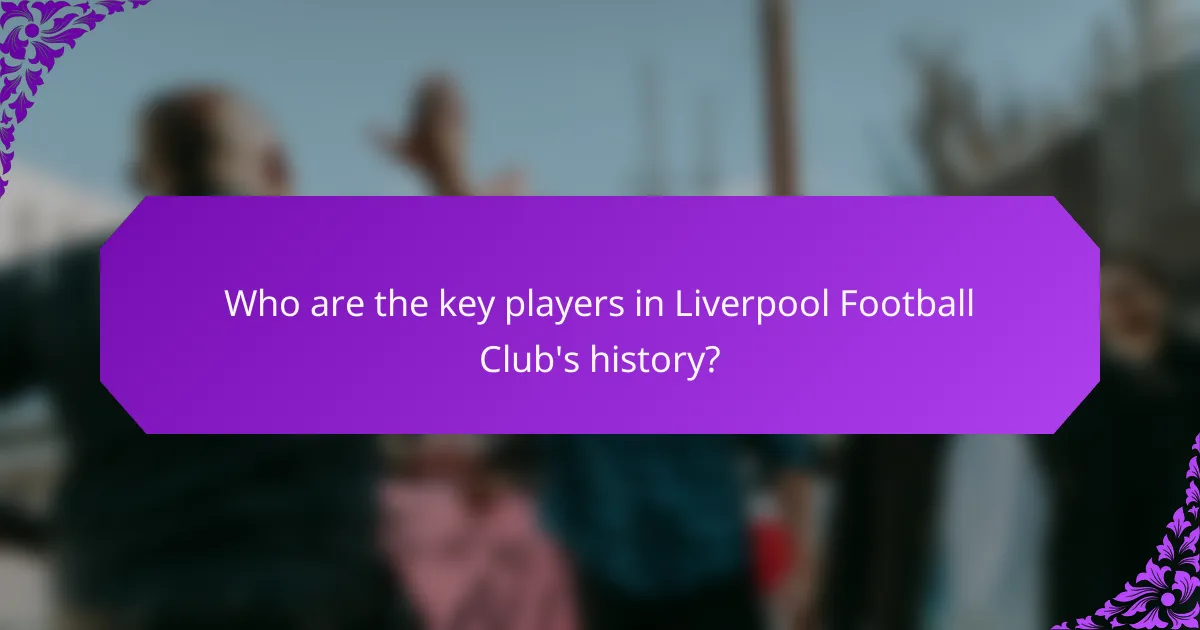Liverpool Football Club has a rich history shaped by key players whose contributions have been vital to the club’s success. Notable figures include Steven Gerrard, known for his leadership and goal-scoring ability; Kenny Dalglish, a legendary forward and manager; and Ian Rush, the all-time leading goal scorer. Recent stars like Mohamed Salah, Sadio Mané, Virgil van Dijk, and Alisson Becker have also played crucial roles in securing major trophies, including the Premier League and Champions League. The evolution of these players’ contributions reflects changes in playing style and the club’s strategic focus on both individual talent and teamwork, establishing Liverpool as one of the most successful football clubs in history.

Who are the key players in Liverpool Football Club’s history?
Key players in Liverpool Football Club’s history include Steven Gerrard, Kenny Dalglish, and Ian Rush. Steven Gerrard is known for his leadership and midfield prowess. He made 710 appearances and scored 185 goals for the club. Kenny Dalglish is a legendary forward and manager. He won multiple league titles and European trophies during his time. Ian Rush is Liverpool’s all-time leading goal scorer with 346 goals. These players significantly contributed to the club’s success and legacy. Their achievements helped establish Liverpool as one of the most successful football clubs in history.
What roles have these players played in the club’s success?
Key players in Liverpool Football Club have played crucial roles in the club’s success. Their contributions include scoring goals, providing assists, and solidifying defense. For instance, players like Steven Gerrard have been instrumental in midfield leadership, guiding the team to multiple trophies. Mohamed Salah has significantly boosted the team’s attacking prowess, scoring over 100 goals since his arrival in 2017. Virgil van Dijk has transformed the defense, contributing to a significant reduction in goals conceded. These players have collectively helped Liverpool secure the UEFA Champions League title in 2019 and the Premier League title in 2020, marking a return to glory for the club. Their individual performances and teamwork have been vital in achieving these successes.
How have these players contributed to Liverpool’s achievements over the years?
Key players have significantly contributed to Liverpool’s achievements through their performances and leadership. Players like Steven Gerrard have been pivotal, leading the team to UEFA Champions League glory in 2005. Gerrard’s inspirational captaincy and crucial goals helped secure memorable victories. Additionally, players such as Mohamed Salah have transformed the team’s attacking capabilities. Salah’s record-breaking goal tally in the Premier League has propelled Liverpool to multiple titles. Defensively, Virgil van Dijk has strengthened the backline, contributing to the team’s success in both domestic and European competitions. His presence has improved overall team performance and stability. Collectively, these players have played vital roles in winning major trophies, including the Premier League, FA Cup, and UEFA Champions League. Their contributions are evident in the club’s rich history and ongoing success.
What milestones have these players reached during their time at the club?
It is not possible to provide a specific answer regarding the milestones reached by players at Liverpool Football Club without additional context about which players are being referred to. Each player’s milestones can vary significantly based on their individual achievements, match appearances, goals scored, and contributions to the team’s success.
Why are these players considered pivotal to Liverpool’s legacy?
These players are considered pivotal to Liverpool’s legacy due to their significant contributions to the club’s success. Their performances have led to numerous titles, including league championships and European trophies. For instance, players like Steven Gerrard and Kenny Dalglish are iconic figures associated with pivotal moments in the club’s history. Gerrard’s leadership and crucial goals in key matches have solidified his status. Dalglish’s managerial success and playing career greatly influenced the club’s culture and winning mentality. Additionally, their ability to inspire teammates and fans has created lasting memories and a strong emotional connection to the club. This impact has shaped Liverpool’s identity and tradition in football.
What unique attributes do these players bring to the team?
Unique attributes of key players in Liverpool Football Club include leadership, technical skill, and versatility. Leadership is exemplified by players like Jordan Henderson, who motivates teammates and sets a strong example. Technical skill is showcased by Mohamed Salah, whose dribbling and finishing abilities are elite. Versatility is seen in players like James Milner, who can perform in multiple positions effectively. These attributes enhance team cohesion and performance on the pitch. Each player’s unique traits contribute significantly to the club’s overall success and competitive edge in matches.
How have these players influenced the club’s culture and identity?
These players have significantly shaped Liverpool Football Club’s culture and identity. Their dedication and performances have fostered a winning mentality within the team. For example, players like Steven Gerrard epitomized loyalty and leadership, becoming a symbol of the club’s values. Their contributions on the pitch have inspired future generations of players. This influence extends to the passionate fanbase, who resonate with the players’ commitment. The players’ successes in key matches have created a legacy that defines the club’s identity. The emphasis on teamwork and resilience has become integral to Liverpool’s culture. Overall, these players have left an indelible mark on the club’s ethos and community.

What specific contributions have these players made to Liverpool Football Club?
Key players have made significant contributions to Liverpool Football Club. Mohamed Salah has scored over 130 goals since joining in 2017. His record-breaking performance includes winning the Premier League Golden Boot twice. Sadio Mané played a crucial role in the team’s 2019 Champions League victory, scoring crucial goals throughout the tournament. Virgil van Dijk has strengthened the defense since his arrival in 2018, contributing to Liverpool’s impressive clean sheet record. Alisson Becker, as a goalkeeper, has made key saves that secured vital points in matches. These contributions have collectively led Liverpool to win the Premier League, Champions League, and other major trophies in recent years.
How have individual performances impacted the team’s successes?
Individual performances have significantly impacted Liverpool Football Club’s successes. Key players have consistently delivered exceptional performances in crucial matches. For example, Mohamed Salah’s goal-scoring ability has been vital in securing points during the Premier League and Champions League. His record of 20 goals in the 2019-2020 season helped Liverpool clinch their first league title in 30 years. Additionally, Virgil van Dijk’s defensive prowess has strengthened the team’s backline, contributing to a record 32 wins in the 2019-2020 season. Alisson Becker’s goalkeeping skills have also been instrumental, with his 13 clean sheets in the same season playing a critical role in the team’s overall success. These individual contributions collectively elevate the team’s performance and lead to greater achievements.
What are some memorable moments or matches featuring these players?
Liverpool Football Club has had numerous memorable matches featuring key players. One significant moment was the 2005 UEFA Champions League final. Liverpool staged a remarkable comeback from a 3-0 deficit against AC Milan to win 3-2 on penalties. Steven Gerrard played a crucial role in this match, scoring the first goal that ignited the comeback.
Another memorable match was the 1989 FA Cup final. Liverpool faced Everton in a tense match that ended 3-2 in favor of Liverpool. This match is remembered for its high stakes and the intense rivalry between the two clubs.
In the 2018 UEFA Champions League final, Mohamed Salah scored the opening goal against Real Madrid. Although Liverpool ultimately lost 3-1, Salah’s performance solidified his status as a key player for the club.
Additionally, the 1977 European Cup final is notable. Liverpool defeated Borussia Mönchengladbach 3-1, marking the club’s first European Cup victory. This match was pivotal in establishing Liverpool as a powerhouse in European football.
These matches highlight the contributions of key players in Liverpool’s history and their impact on the club’s success.
How do statistics reflect their contributions to the club?
Statistics reflect key players’ contributions to Liverpool Football Club through measurable performance metrics. Goals scored, assists provided, and defensive actions are quantifiable aspects of their impact. For instance, Mohamed Salah’s goal tally exceeded 20 goals in multiple seasons, showcasing his scoring ability. Additionally, Virgil van Dijk’s defensive statistics highlight his role in reducing goals conceded, with Liverpool achieving a league-best defense during his tenure. These statistics provide concrete evidence of individual contributions to the club’s overall success. Analyzing these figures allows fans and analysts to assess player effectiveness and influence on match outcomes.
What leadership qualities do these key players exhibit?
Key players in Liverpool Football Club exhibit qualities such as resilience, communication, and strategic thinking. Resilience allows them to overcome challenges and setbacks during matches. Effective communication fosters teamwork and ensures all players are aligned on tactics. Strategic thinking enables them to make quick decisions under pressure. Additionally, they demonstrate accountability by taking responsibility for their performance. These leadership qualities contribute significantly to the team’s overall success and cohesion on the field. Their ability to inspire and motivate teammates further enhances their leadership impact.
How do these qualities inspire other team members?
The qualities of key players in Liverpool Football Club inspire other team members by fostering a culture of excellence. These players exhibit strong leadership, resilience, and a commitment to teamwork. Their dedication encourages teammates to elevate their performance levels. For instance, when a player demonstrates exceptional work ethic, others are motivated to match that intensity. Additionally, the ability to remain calm under pressure sets a standard for handling challenging situations. This influences the entire team’s mentality, promoting a collective drive towards success. Historical data shows that teams with strong leaders often achieve higher win rates, reinforcing the impact of these qualities.
What role do these players play in mentoring younger teammates?
Key players in Liverpool Football Club serve as mentors to younger teammates by providing guidance and support. They share their experience and knowledge of the game. This mentorship helps younger players develop their skills and understanding of tactics. For instance, veteran players often lead by example during training sessions. They demonstrate professionalism and dedication, which younger players can emulate. Additionally, these key players offer advice on handling pressure in high-stakes matches. Their presence fosters a positive team culture, encouraging personal and professional growth among younger teammates. This role is crucial for maintaining the club’s competitive edge and ensuring a strong future.

How have the contributions of key players evolved over time?
The contributions of key players at Liverpool Football Club have evolved significantly over time. In the early years, players like Bill Shankly and Bob Paisley shaped the club’s identity and success through tactical innovations and strong leadership. Their contributions established a winning culture that laid the foundation for future achievements.
As the club progressed into the 1980s, players such as Kenny Dalglish became pivotal in both goal-scoring and playmaking. Dalglish’s dual role enhanced the team’s attacking capabilities and solidified Liverpool’s dominance in English football.
In the 2000s, the emergence of players like Steven Gerrard marked a shift towards individual brilliance. Gerrard’s leadership and ability to influence crucial matches were instrumental in securing multiple trophies, including the memorable 2005 Champions League victory.
Recently, contributions from players like Mohamed Salah and Virgil van Dijk have redefined the club’s competitive edge. Salah’s goal-scoring prowess and van Dijk’s defensive solidity have been vital in Liverpool’s resurgence in both domestic and European competitions.
Overall, the evolution of contributions reflects changes in playing style, leadership roles, and the club’s strategic focus on both individual talent and cohesive teamwork.
What changes have occurred in player roles throughout different eras?
Player roles in football have evolved significantly over different eras. In the early 20th century, players often had fixed positions with limited tactical flexibility. The introduction of the WM formation in the 1920s allowed for more dynamic roles, particularly for forwards and midfielders.
By the 1970s, the total football philosophy emphasized fluidity and interchangeability among players. This led to more versatile roles, where players were expected to contribute both defensively and offensively. In recent decades, the rise of specialized roles has emerged, such as the deep-lying playmaker and the false nine.
These changes reflect advancements in training, tactics, and the overall pace of the game. Modern players are often required to possess a broader skill set, adapting to various formations and strategies. This evolution showcases the increasing complexity and demands of player roles in contemporary football.
How have tactical shifts influenced player contributions at Liverpool?
Tactical shifts at Liverpool have significantly influenced player contributions. Changes in formation and strategy have enhanced individual roles. For example, the transition to a high-pressing system has increased the defensive contributions of forwards. Players like Roberto Firmino have adapted by pressing opponents and creating turnovers. Additionally, tactical adjustments have allowed full-backs like Trent Alexander-Arnold to push forward, contributing more assists. Under Jürgen Klopp, the focus on counter-attacking play has seen midfielders like Gini Wijnaldum become vital in transition phases. These shifts have maximized the strengths of various players and led to overall team success. This adaptability has been crucial in securing titles, including the Premier League and Champions League.
What impact has player recruitment had on the club’s success?
Player recruitment has significantly influenced Liverpool Football Club’s success. Strategic signings have bolstered the team’s performance and competitiveness. For instance, the acquisition of Virgil van Dijk in 2018 transformed the defense. His presence led to a notable increase in clean sheets, contributing to Liverpool’s 2019 UEFA Champions League victory. Additionally, the recruitment of Alisson Becker improved goalkeeping stability. This resulted in fewer goals conceded, aiding in the club’s Premier League title win in 2020. Overall, effective player recruitment has been pivotal in Liverpool’s recent achievements and consistent top-tier performance.
What challenges have key players faced in their careers at Liverpool?
Key players at Liverpool have faced various challenges throughout their careers. Injuries have significantly impacted the performance of players like Virgil van Dijk, who suffered a serious knee injury in 2020. This injury sidelined him for several months, affecting the team’s defensive capabilities. Additionally, players like Mohamed Salah have faced intense scrutiny and pressure to perform consistently at a high level.
The transition periods between managers have also posed challenges. Players must adapt to different tactical systems and expectations, as seen during the managerial changes from Brendan Rodgers to Jürgen Klopp. Furthermore, key players often deal with the pressure of high expectations from fans and media, particularly during title races or crucial matches.
Off-field issues, such as personal matters or contract negotiations, can also create distractions. For instance, players like Sadio Mané have had to navigate contract speculation while maintaining focus on their performances. These challenges highlight the resilience and adaptability required of key players at Liverpool.
How have injuries or form issues affected their contributions?
Injuries and form issues have significantly affected the contributions of key players in Liverpool Football Club. For instance, when a player like Virgil van Dijk suffered a serious knee injury in October 2020, his absence impacted the team’s defensive solidity. Liverpool’s goals conceded per match increased from 0.8 to 1.5 during his recovery period. Similarly, Mohamed Salah’s inconsistent form during the 2021 season saw his goal tally drop from 22 to 22 in the league. These fluctuations in player availability and performance directly correlate with the team’s overall success and results. Thus, injuries and form issues have led to reduced contributions from pivotal players, affecting Liverpool’s competitive edge.
What strategies have players used to overcome these challenges?
Players have used teamwork and communication to overcome challenges. They focus on building strong relationships on and off the pitch. This enhances their understanding during matches. Players also engage in rigorous training to improve their skills. They analyze game footage to identify weaknesses. This allows them to adapt strategies in real-time. Mental resilience is another key strategy. Players often rely on sports psychologists to maintain focus. These approaches have contributed to Liverpool’s success in high-pressure situations.
What can fans learn from the contributions of key players at Liverpool?
Fans can learn the importance of teamwork and resilience from key players at Liverpool. Players like Steven Gerrard exemplified leadership and dedication, inspiring teammates to perform at their best. Mohamed Salah’s work ethic and goal-scoring ability demonstrate the value of individual skill contributing to team success. Virgil van Dijk’s defensive prowess highlights the significance of a strong foundation in defense for overall performance. These contributions show that success is built on both individual excellence and collective effort, reinforcing the idea that every player plays a crucial role in achieving common goals.
How can aspiring athletes apply these lessons in their own careers?
Aspiring athletes can apply lessons from key players in Liverpool Football Club’s success by emulating their work ethic and dedication. These players consistently demonstrate commitment to training and improvement. For instance, they set specific goals and work tirelessly to achieve them. This approach fosters discipline and resilience. Additionally, they emphasize teamwork and communication, which are crucial in any sport. Learning to collaborate effectively with teammates enhances overall performance. Observing their adaptability in high-pressure situations can also provide valuable insights. Athletes can learn to remain focused and composed during challenges. Lastly, understanding the importance of mental strength and a positive mindset can significantly impact an athlete’s career trajectory.
What best practices can be derived from the experiences of these players?
Best practices derived from the experiences of key players at Liverpool Football Club include strong teamwork, effective communication, and resilience. These players consistently emphasized the importance of collaboration on and off the pitch. For example, their ability to support each other during challenging matches led to improved performance. Additionally, maintaining open lines of communication among teammates fostered trust and unity. Players demonstrated resilience by overcoming setbacks, which contributed to their overall success. These practices are evident in Liverpool’s achievements, including their 2019 UEFA Champions League victory, showcasing the effectiveness of these strategies.
Key players in Liverpool Football Club’s success include Steven Gerrard, Kenny Dalglish, Ian Rush, Mohamed Salah, and Virgil van Dijk. Their contributions range from leadership and goal-scoring to defensive strength, significantly impacting the club’s achievements, including multiple league titles and European trophies. The article explores the roles these players have played in shaping Liverpool’s legacy, their unique attributes, memorable moments, and the evolution of their contributions over time. It also highlights the challenges they faced and the lessons aspiring athletes can learn from their experiences.
